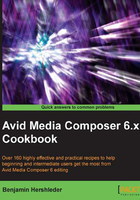
Creating Bin Layouts
Bin Layouts made their debut in Media Composer version 6. Like Workspaces, they are a task-focused feature that, with just a visit to a menu or a push of a button, allow you to instantly reveal the bins you want and to have them arranged just as you've saved them, including in tabbed sets.
Bin Layouts can be activated independently of Workspaces, or they can be activated automatically at the same time you activate a Workspace. Avid refers to this as linking. That feature is covered in the Linking Bin Layouts with Workspaces and Mapping Workspaces and Bin Layouts recipes.
An important note is that Bin Layouts are not saved as part of your User Settings. They are actually specific to a particular Project. See the There's more… section in this recipe for additional information on this.
How to do it...
To create Bin Layouts, perform the following steps:
- Go to Windows menu | Bin Layout.
- From the submenu, do one of the following:
- Select an existing Bin Layout
- Select the New Bin Layout command
- Once a Bin Layout is selected or created, it is activated and is said to be the "current" Bin Layout. The currently active Bin Layout will have a check mark next to it in the menu.
- Open the bins you want to help you perform a specific task. Arrange and resize them, including placing bins into tabbed sets and arrange them on your screen(s) as needed.
- Once your bins are arranged as you like, you'll make Media Composer remember that layout. Go to Windows menu | Bin Layout | Save Current.
- Once the Bin Layout is saved, you may move and close them as needed without actually updating the Layout. Because if you don't save those changes, the next time you select that Bin layout it will return to its previously saved configuration. If you make changes and you do indeed want to update the currently active Bin Layout, then go to Windows menu | Bin Layout | Save Current. If you find yourself updating your Bin Layouts frequently, you may find it convenient to map the Save Current menu selection to a button in the interface or on the keyboard. See the Mapping buttons and menu selections recipe later in this chapter for more information.
Tip
At the time of writing, if a new bin is opened and the current Bin View is not saved to include this bin, then the bin will close if/when that Bin View is reselected (either manually or because that Bin View is linked to a Workspace). Further, if a bin that is included in a Bin View is deleted and the layout has not been resaved, then you may get an error message when that Bin View is reactivated.
There's more...
For easier access, you can map your Bin Layouts to buttons in the interface and/or on the keyboard. Further, you can link them to one or more Workspaces so that they become active when that Workspace is activated. This is covered in the Linking Bin Layouts with Workspaces and Mapping Workspaces and Bin Layouts recipes later in this chapter.
However, since Bin Layouts are Project-specific settings, rather than part of your User Profile Settings, the question arises—what happens if you map a Bin Layout to a button and/or link it to a Workspace and use those settings with another Project?
Here's an example. While in a Project called "Wisconsin" you created a Bin Layout for three bins@ one for music, one for sound effects, and one for voiceover. You named this Bin Layout "Music+SFX+VO". You wanted to use this Bin Layout frequently, so you mapped it to a button on your Timeline Toolbar and you linked it to your Audio Editing Workspace. While in the "Wisconsin" project, the button appears on the Timeline Toolbar with a line below the abbreviation.
A month later, the "Wisconsin" project gets completed and you begin working on another project called "California". When working on the "California" project, you use your previously saved User Settings that include the button mapping and linking you did in the "Wisconsin" project for the Bin Layout called "Music+SFX+VO". Since that Bin Layout doesn't exist in the "California" Project, when you activate the Audio Editing Workspace, no bins open and, in the Timeline Toolbar, the mapped button's abbreviation is now italicized and no longer has a line beneath it.
If you want that Bin Layout to be activated while in the "California" project, then do the following:
- Create a new Bin Layout and name it exactly as it was named when it was originally mapped and/or linked. In this example, it would be named "Music+SFX+VO". You must pay particular attention to spaces, symbols, and uppercase/lowercase letters. If the name is not identical in all respects, then it will not work. If it is named identically, then the text appearing on the button it is mapped to will not be italicized and will have a line underneath the abbreviation.
- While that Bin Layout is active, create and/or open the bins you want associated with it. There do not have to be the same number of bins as before, nor do the names have to be the same as before.
- Arrange the bins as needed for that Bin Layout.
- Save the Bin layout by selecting Windows | Bin Layout | Save Current.